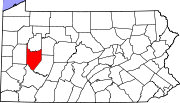
The Allegheny River is a 325-mile-long (523 km) headwater stream of the Ohio River that is located in western Pennsylvania and New York in the United States. It runs from its headwaters just below the middle of Pennsylvania's northern border, northwesterly into New York, then in a zigzag southwesterly across the border and through Western Pennsylvania to join the Monongahela River at the Forks of the Ohio at Point State Park in Downtown Pittsburgh, Pennsylvania.

Allegheny County is a county in Pennsylvania, United States. As of the 2020 census, the population was 1,250,578, making it the state's second-most populous county, after Philadelphia County. Its county seat and most populous city is Pittsburgh, Pennsylvania's second most populous city. The county is part of the Greater Pittsburgh region of the state, and is the center of the Pittsburgh media market.
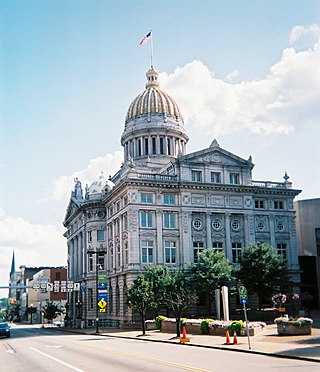
Westmoreland County is a county in the Commonwealth of Pennsylvania, United States, located in the Pittsburgh Metropolitan Statistical Area. As of the 2020 census, the population was 354,663. The county seat is Greensburg and the most populous community is Hempfield Township. It is named after Westmorland, a historic county of England. The county is part of the Southwest Pennsylvania region of the state.

Jefferson County is a county in the Commonwealth of Pennsylvania. As of the 2020 census, the population was 44,492. Its county seat is Brookville. The county was established on March 26, 1804, from part of Lycoming County and later organized in 1830. It is named for President Thomas Jefferson. It is home to Punxsutawney Phil, the most famous groundhog that predicts when spring will come every February 2 on Groundhog Day. The county is part of the North Central Pennsylvania region of the state.

Indiana County is a county in the Commonwealth of Pennsylvania. It is located in the west central part of Pennsylvania. As of the 2020 census, the population was 83,246. Its county seat is Indiana. Indiana County comprises the Indiana, PA Micropolitan Statistical Area, which is also included in the Pittsburgh-New Castle-Weirton, PA-WV-OH Combined Statistical Area. The county is part of the Southwest Pennsylvania region of the state.

Clarion County is a county in the Commonwealth of Pennsylvania. As of the 2020 census, the population was 37,241. Its county seat is Clarion. The county was formed on March 11, 1839, from parts of Venango and Armstrong counties. Clarion County is entirely defined as part of the Pittsburgh media market. The county is part of the North Central Pennsylvania region of the state.

Ford City is a borough in Armstrong County, Pennsylvania, United States, 40 miles (64 km) northeast of Pittsburgh along the east bank of the Allegheny River and 4 miles (6 km) south of Kittanning, the county seat. The population was 2,859 at the 2020 census. It is part of the Pittsburgh metropolitan area.

Freeport is a borough in Armstrong County, Pennsylvania, United States. It is situated along the Allegheny River in the southwestern corner of the county. The population was 1,736 at the 2020 census.

Gilpin Township is a Second class Township in Armstrong County, Pennsylvania, United States. At the 2010 census it had a population of 2,496. As of the 2020 census, its population had decreased to 2,411, a 3.4% decrease.

Worthington is a borough in Armstrong County, Pennsylvania, United States. The population was 594 at the 2020 census.

Smicksburg is a borough in Indiana County, Pennsylvania, United States. The population was 57 at the 2020 census, and it is one of the smallest incorporated boroughs in Pennsylvania. It was founded by the Reverend J. George Schmick.

Allegheny Township is a township in Westmoreland County, Pennsylvania, United States. The population was 8,316 at the 2020 census, an increase from 8,002 at the 2000 census. It is the northernmost municipality of Westmoreland County. The municipality borders the townships of Buffalo, Harrison, Upper Burrell, and Washington; and the boroughs of Oklahoma, Vandergrift, Leechburg, West Leechburg, Lower Burrell, Freeport and Hyde Park. It is served by the Kiski Area School District.

The Kiskiminetas River is a tributary of the Allegheny River, approximately 27 miles (43 km) long, in Western Pennsylvania in the United States. The region stretching from the northern side of Harmar Township, Pennsylvania to the Kiskiminetas towns is often referred to by the locals as the Alle-Kiski Valley after the rivers.
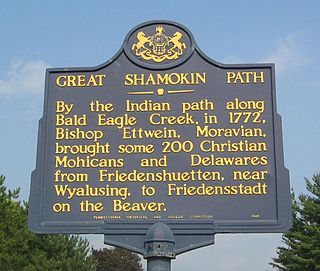
The Great Shamokin Path was a major Native American trail in the U.S. State of Pennsylvania that ran from the native village of Shamokin along the left bank of the West Branch Susquehanna River north and then west to the Great Island. There it left the river and continued further west to Chinklacamoose and finally Kittanning on the Allegheny River.
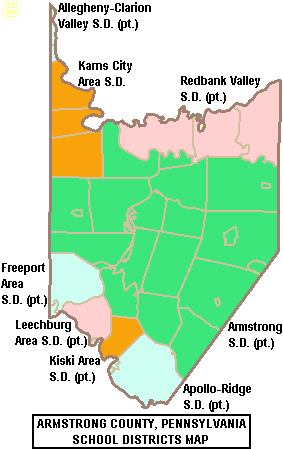
The Armstrong School District is a large, public school district which encompasses approximately 437 square miles (1,130 km2). The district is one of the 500 public school districts of Pennsylvania. In Armstrong County, Pennsylvania, Armstrong School District covers the Boroughs of Applewold, Atwood, Dayton, Elderton, Ford City, Ford Cliff, Kittanning, Manorville, Rural Valley, West Kittanning and Worthington and the Townships of Bethel Township, Boggs Township, Burrell Township, Cadogan Township, Cowanshannock Township, East Franklin Township, Kittanning Township, Manor Township, North Buffalo Township, Pine Township, Plumcreek Township, Rayburn Township, South Bend Township, Valley Township, Washington Township, Wayne Township and West Franklin Township. In Indiana County, Pennsylvania, the district includes the Borough of Smicksburg and West Mahoning Township. According to 2000 federal census data, it served a resident population of 44,970. By 2010, the District's population had declined to 43,301 people. In 2009, Armstrong School District residents' per capita income was $15,449, while the median family income was $36,907.

The 60th Pennsylvania House of Representatives District is located in western Pennsylvania has been represented by Abby Major since 2021.
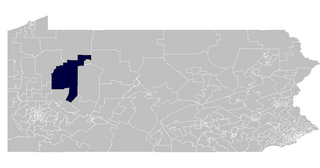
The 63rd Pennsylvania House of Representatives District is in Western Pennsylvania and has been represented by Donna Oberlander since 2009.

Pennsylvania Route 128 is a 15.8-mile-long (25.4 km) state highway located in Armstrong County, Pennsylvania. The southern terminus is at PA 356 in Freeport. The northern terminus is at PA 66 in Ford City.

Pennsylvania Route 356 is a 32.5-mile-long (52.3 km) state highway located in Westmoreland, Allegheny, Butler, and Armstrong counties in Pennsylvania. The southern terminus is at PA 66 near Oklahoma. The northern terminus is at U.S. Route 422 (US 422) near Butler.

Pennsylvania Route 954 is a 35-mile-long (56 km) state highway located in Indiana County, Pennsylvania. The southern terminus is at PA 56 in Center Township. The northern terminus is at PA 210 in North Mahoning Township. PA 954 is a two-lane undivided road that serves Indiana, Creekside, Plumville, and Smicksburg. The route intersects U.S. Route 422 and PA 286 in Indiana, PA 110 in Creekside, and PA 85/PA 210 in Plumville. PA 954 was designated in 1928 between Smicksburg and PA 210 in Trade City. The route was extended south to Denton by 1930 and US 422 and PA 80 in Indiana during the 1930s. PA 954 was lengthened to its current terminus in 1971.


























